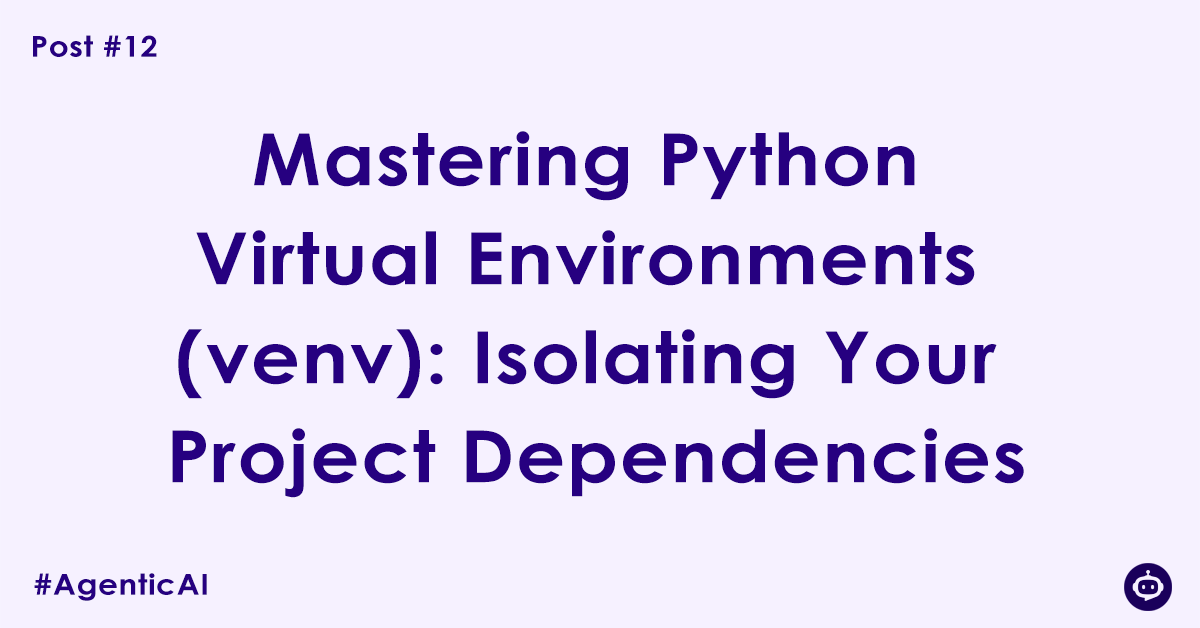In our last post, we set up a professional development environment. One of the steps was to create and activate something called a “virtual environment.” We mentioned it was a “golden rule,” but its importance is so fundamental that it deserves its own dedicated guide.
To understand why, imagine you have just one toolbox for every single project in your house—plumbing, electrical work, car repair, and woodworking. Soon, your toolbox is a chaotic mess of wrenches, wires, screwdrivers, and wood glue. A tool you need for your car is incompatible with a plumbing fixture, and finding the right screw is a nightmare.
This is exactly what your computer’s main Python installation becomes without virtual environments: a single, global toolbox for every project you’ll ever work on. Mastering virtual environments is the step you take to move from a hobbyist’s messy toolbox to a professional’s organized workshop.
The “Why”: Escaping Dependency Hell
The core problem that virtual environments solve is called “dependency management,” often referred to as “Dependency Hell.” It boils down to two major issues:
1. Conflicting Project Requirements:
Imagine you start Project_A, an AI agent that requires cool-library version 1.0. You install it globally. A month later, you start Project_B, which needs the new and improved cool-library version 2.0. You upgrade the global package. When you go back to work on Project_A, it suddenly breaks because the functions it relied on in version 1.0 were changed or removed in version 2.0. You are stuck.
2. Project Portability and Reproducibility:
You finish your amazing agent and want to share it with a colleague or deploy it to a server. You send them your Python code, but how do they know which of the dozens of libraries you used, and more importantly, which versions of those libraries? Your colleague spends hours trying to guess and install the right dependencies, and the project still might not run correctly. This makes collaboration and deployment impossible.
A virtual environment solves this by creating an isolated, self-contained folder for each project. This folder contains a specific version of Python and its own dedicated set of installed libraries, completely separate from all other projects.
The “How”: A Practical Workflow with venv
Python comes with a built-in module called venv that makes this process simple. Here’s the complete workflow.
Step 1: Create the Environment
It’s a strong convention to create the virtual environment inside your project’s main folder and name it venv.
In your terminal, from your project’s root directory:
python -m venv venvpython -m venv: This command tells Python to run its built-invenvmodule.venv: This is the name of the folder that will be created to house your isolated environment.
Step 2: Activate the Environment
Creating the environment doesn’t turn it on. You need to “activate” it.
- On Windows (PowerShell/CMD):PowerShell
.\venv\Scripts\activate - On macOS / Linux:Bash
source venv/bin/activate
You will immediately see your terminal prompt change, prefixed with (venv). This is your visual confirmation that the environment is active. From this point on, any pip commands will only affect this local environment.
Step 3: Install Libraries and Create a requirements.txt
Now that your environment is active, you can install packages.
pip install openai requests python-dotenvThis installs these libraries only inside the venv folder.
To make your project reproducible, you must create a list of its dependencies. This is the professional standard. The pip freeze command automatically generates this list for you.
pip freeze > requirements.txtThis creates a requirements.txt file in your project. Now, when a colleague gets your code, they can create their own virtual environment, activate it, and install the exact same set of libraries with one simple command:
pip install -r requirements.txtThis single file is the key to portable and collaborative Python projects.
Step 4: Deactivate the Environment
When you’re done working on your project, you can deactivate the environment to return to your global Python context.
deactivateThe (venv) prefix will disappear from your terminal prompt.
Best Practices and Common Questions
- Should I commit
venvto Git? ABSOLUTELY NOT. Thevenvfolder can contain thousands of files and is specific to your operating system. It should always be added to your.gitignorefile. The project is fully reproducible from therequirements.txtfile alone. - How do I know which environment I’m in? Look for the
(venv)prefix in your terminal. If it’s not there, your environment is not active. - What if I need to use different versions of Python itself?
venvcreates an environment using the Python version you used to create it. For managing multiple installations of Python (e.g., Python 3.9 and 3.11) on the same machine, developers use tools likepyenv. However, masteringvenvis the essential first step.
Conclusion
Using virtual environments is not an optional “advanced” trick—it is the foundational practice for all serious Python development. It turns a chaotic, fragile workflow into an organized, robust, and professional one.
By mastering the simple venv workflow, you’ve overcome one of the biggest hurdles for new developers. Your projects are now isolated, reproducible, and ready for collaboration—the true mark of a professional developer.
Author

Experienced Cloud & DevOps Engineer with hands-on experience in AWS, GCP, Terraform, Ansible, ELK, Docker, Git, GitLab, Python, PowerShell, Shell, and theoretical knowledge on Azure, Kubernetes & Jenkins. In my free time, I write blogs on ckdbtech.com
